Hanoi is the capital of Vietnam and an excellent jumping off point for exploring the northern region of the country. If you want to venture into the popular regions of Ha Long, Ninh Binh, Ha Giang or Sa Pa, you will almost definitely be going through Hanoi. More than just a jumping off point, Hanoi is a great city to visit in its own right. If you’re in this region, I recommend taking at least a few days in Hanoi to explore, eat and appreciate the historical significance of Vietnam’s second-largest city.
Though Hanoi has officially been Vietnam’s capital since 1976, the city enjoyed multiple stints as a capital since the third century BCE. In present day, it is known for its colonial architecture, temples, museums, markets and amazing food.
When visiting Vietnam, I decided to spend about four days in Hanoi. I split my visit into the following structure:
- ~2.5 days before heading to Ha Long Bay
- ~0.5 days between Ha Long Bay and Sa Pa
- 1 day after returning from Sa Pa
I feel like this amount of time was enough to see most highlights in the Old Quarter of the city. However, if you want to spend more time exploring other neighborhoods or taking day trips, maybe plan for longer.
This was my itinerary in Hanoi Old Quarter for half a week.
Day 1: Arrival, Night Market, Hoàn Kiếm Lake
We arrived in Hanoi around 4 p.m. and called a Grab to take us one hour into the Old Quarter. When I booked the Grab, it would only give me the option to pay with cash even though I’d input my credit card details into the app before leaving the US. I’d never experienced that on a rideshare app before! We didn’t have any cash on us yet, but there were multiple ATMs in the Hanoi airport arrivals hall.
It cost ~$12 USD for the entire ride from the airport to our Airbnb/homestay. The driver did ask for a little more money than the app said the ride should cost. Not sure if he was adding his own tip/slightly taking advantage of the cash ride, or if the initial estimate in Grab was just wrong.
We finally got to our place around 5:30. Daylight was fading fast, and so were we. All told, we traveled 29 hours door-to-door. Trying to outrun jet lag, we quickly dropped our bags, changed and immediately headed out into the city. First stop was a coffee place overlooking Hoàn Kiếm Lake that I saw recommended on Reddit. We definitely needed a caffeine boost.
The walk to the coffee shop gave us our first taste of Hanoi’s chaotic traffic. Cars, buses and especially motorbikes share tiny roads along with pedestrians. No one has the right of way, yet everyone has the right of way. Traffic laws and crosswalks appear to be more of a suggestion than a rule. It’s stressful to navigate the first couple of days.
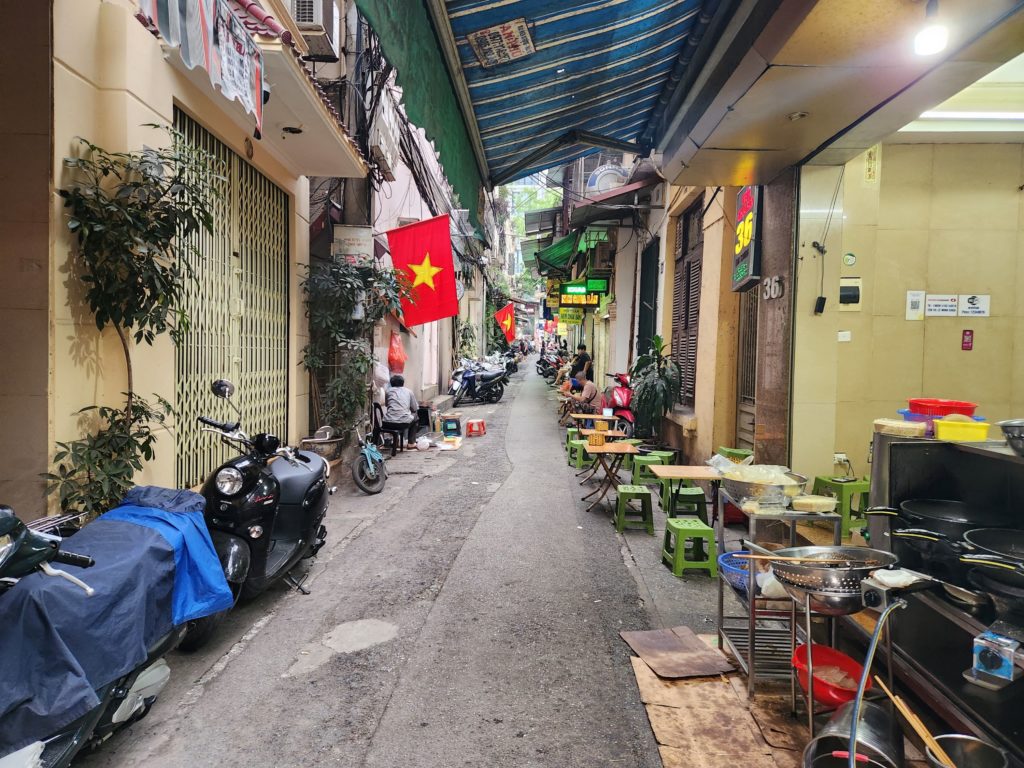
I was excited to explore Hanoi’s famous coffee scene.
There are a few specialty coffees in Hanoi, and I decided to try an iced coconut coffee. It was light, refreshing and had the perfect amount of sweetness. Most importantly, it woke me up for the rest of the evening.
After coffee, we decided to find dinner. The Reddit suggestion went so well that we decided to check out another suggestion called Pho Ga 26. Apparently many restaurants in Hanoi are just named after the main food they make and the street number. The best restaurants seemed to make just 1-3 dishes.
As we approached the restaurant, we saw a woman pulling apart chicken pieces and boiling soup. I’d read that boiling soup was a good sign of a hygienic place to eat. We took a seat on the small plastic chairs and ordered two bowls of phở trộn. Noodles, chicken, fried onions, herbs and a side of broth. After a delicious dinner that we couldn’t believe cost the equivalent of $4 USD, we decided to find the night market.

The Hanoi Old Quarter night market happens Friday to Sunday night.
It has vendors selling all sorts of goods, some street food stalls and live performances. Google said it opened at 8, but stalls were already up and running around 7. The night market streets are mostly closed off from traffic, which makes it more relaxing to walk through them. The odd motorbike might still drive through.
(Note: If you’re not in Hanoi during a weekend, there are other night markets in the city you can see. They might even be easier to shop at because they’re outside the main tourist district.)
We weren’t ready to buy anything yet. Instead, we just walked through the market and took note of what was for sale.
After the night market, we thought we’d get a beer on Beer Street. I’d read about Beer Street on the internet and mistakenly thought it was a chill strip of bars to grab a draft beer and relax. The reality was…not that. It was a few blocks of bars, clubs and restaurants. Employees stood out front shoving menus in your face and trying to usher you into their establishments. Not the vibe I was looking for. We pushed through the throngs of people trying to convince us they had the best drink/food deal and moved on to the lake.
During the weekend, the area around Hoàn Kiếm Lake turns it into a pedestrian-only area. This rule makes it a very pleasant area to walk around and observe life away from the chaos of Hanoi’s traffic. The fountain glowed a violet-purple. Kids and adults of every age were out enjoying the cool (ish) Friday night air and festivities.
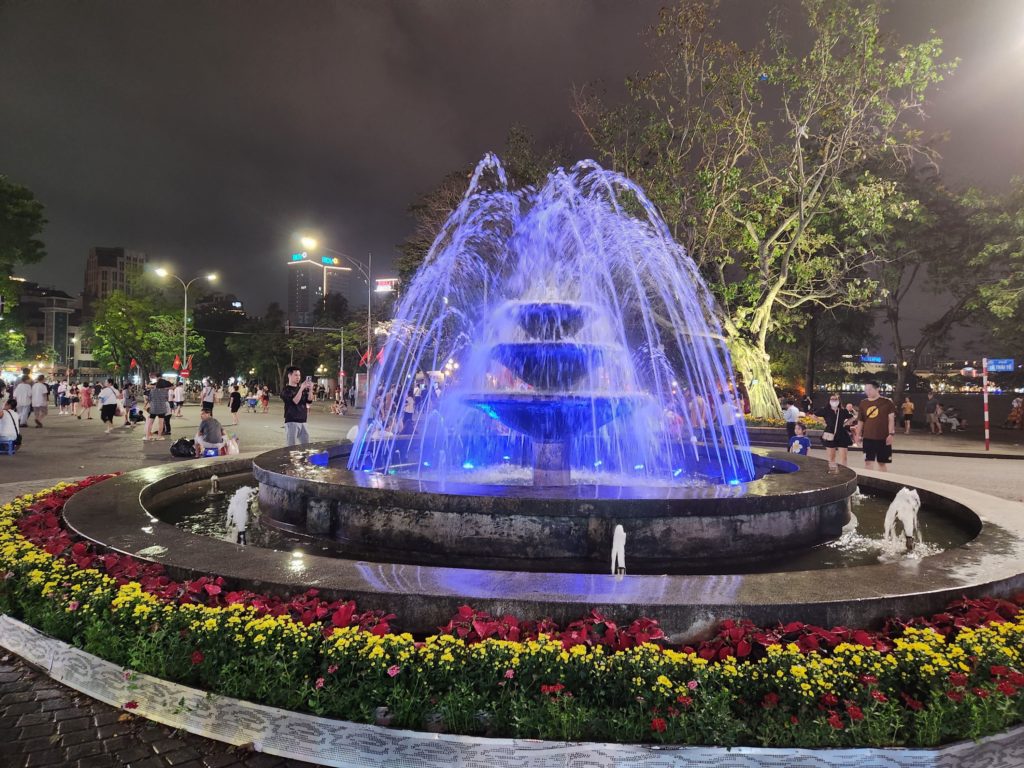
Not only was it a Friday night, but it was the beginning of a holiday weekend: Hung King’s Day, Reunification Day and Labor Day.
There were several live performances at various levels of production quality. It ranged from a trio of musicians with their instruments busking on the street corner to a full-blown professional production on a huge stage in the middle of the street with singers and dancers.
After walking around the lake for a bit and taking in the atmosphere of the city on Friday night, it was time for us to finally sleep.
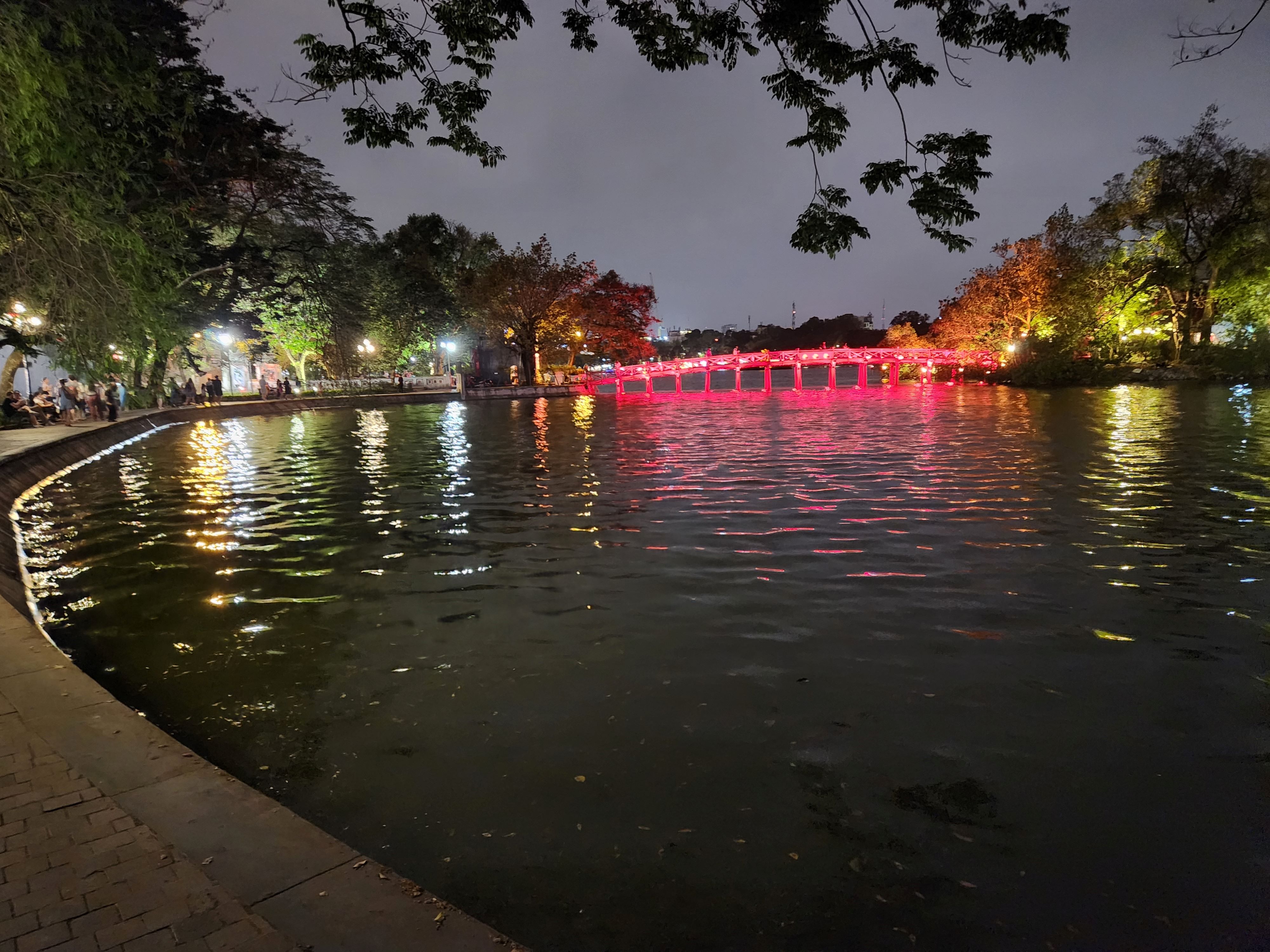
Day 2: Ho Chi Minh Mausoleum & Museum, Temple of Literature, Night Market Round #2
Thanks to jet lag, we woke up bright and early around 5 a.m. After unsuccessfully trying to go back to sleep, we finally decided to get up and start our first full day in Hanoi. Then, it started raining. Booking this trip during shoulder season in late April, I knew there was a chance of rain, but I’d read the storms never last too long. The rain slowed soon enough, so we packed some rain jackets in our day bag and headed into the city.
The first stop was to try another coffee shop. On an Instagram recommendation, we stopped at a Vietnamese chain called Cong Ca Phe where I tried another staple of Hanoi’s coffee scene, white coffee. White coffee (Bạc Xỉu) is phin coffee, condensed milk and coconut milk. It’s strong and delicious.
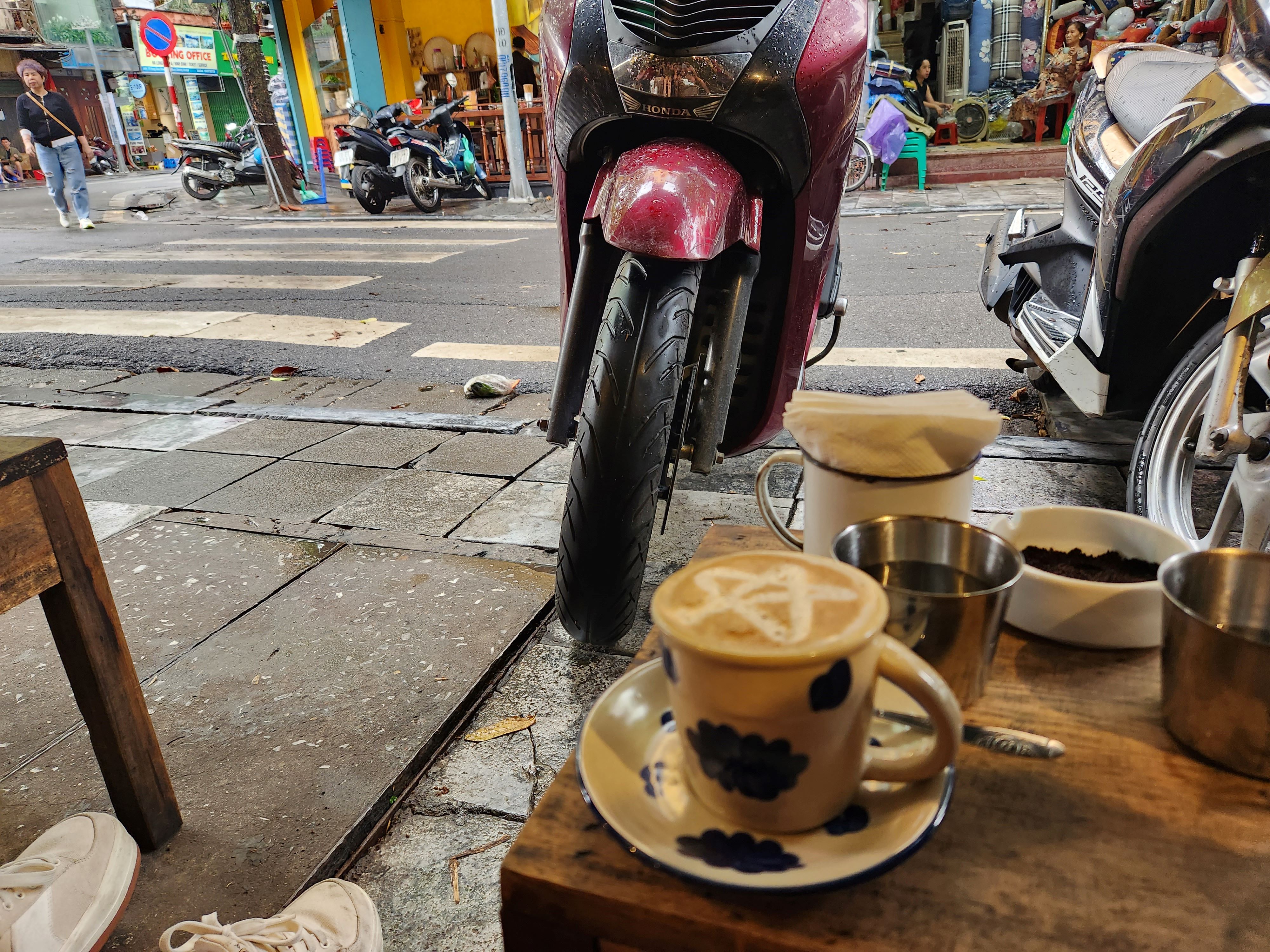
Next stop was one of the main highlights of Hanoi: the Ho Chi Minh Mausoleum. Ho Chi Minh was the president of Vietnam and played a key role in liberating the country from French colonization then leading the country to victory in the war with the US. We learnd his wishes were to be cremated when he died. However, the country wanted future generations to be able to see him and learn about what he’d done for Vietnam.
Anyone can visit the Mausoleum for free, and it is definitely a unique experience. I tried to write about the experience in this post, but it ended up being way too long, so I broke it into a separate post.
After visiting the Mausoleum, we decided to choose between visiting Ho Chi Minh’s house and garden in the complex, or the Ho Chi Minh Museum.
We chose the museum to learn more about Ho Chi Minh’s life and Vietnamese history.
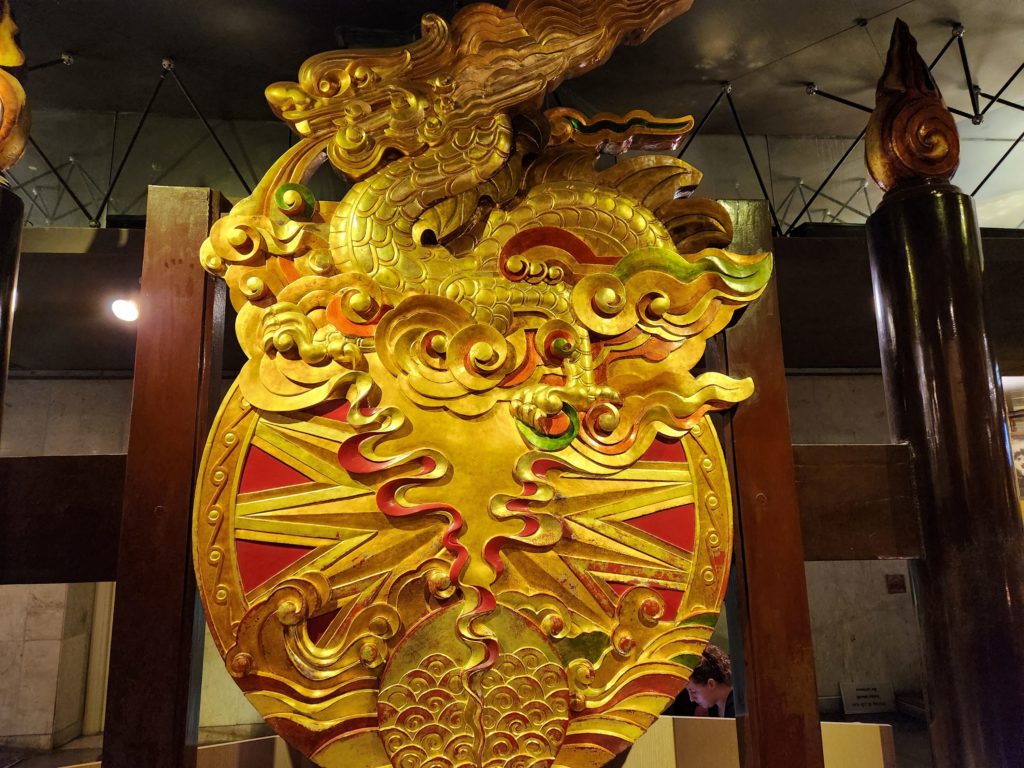
The Mausoleum was free, but the museum cost 40K Vietnamese Dong (VND) each (~$1.50 USD). As soon as we walked in, someone approached us and offered a tour of the museum. Having heard about how many scams there are in Vietnam, I was immediately wary. I asked him how much, and he said it was free unless we wanted to tip at the end. He was also wearing a lanyard with a document stamped with the official tourism board of Vietnam, so I decided to trust him and take his tour.
He ended up being a pretty good tour guide! We more context on the exhibits, and as well as our first insight into the Vietnamese mindset. Overall, we walked away with a deeper appreciation of Vietnamese history and why citizens have such a deep admiration and respect for Ho Chi Minh.
After the museum, we decided to keep exploring Vietnam’s history and walked over to the Temple of Literature. Built in 1070, the Temple of Literature is the site of the first official university of Vietnam. The grounds were still wet from the rain. It just brought the beauty in the temple and landscaped gardens even more. The tickets for the temple were a little over 30K VND each (just over $1 USD). Honestly, I kind of wish we’d had a guide at this location. I think we would have learned more history.
The architecture and landscaping was beautiful and transports you back in time.
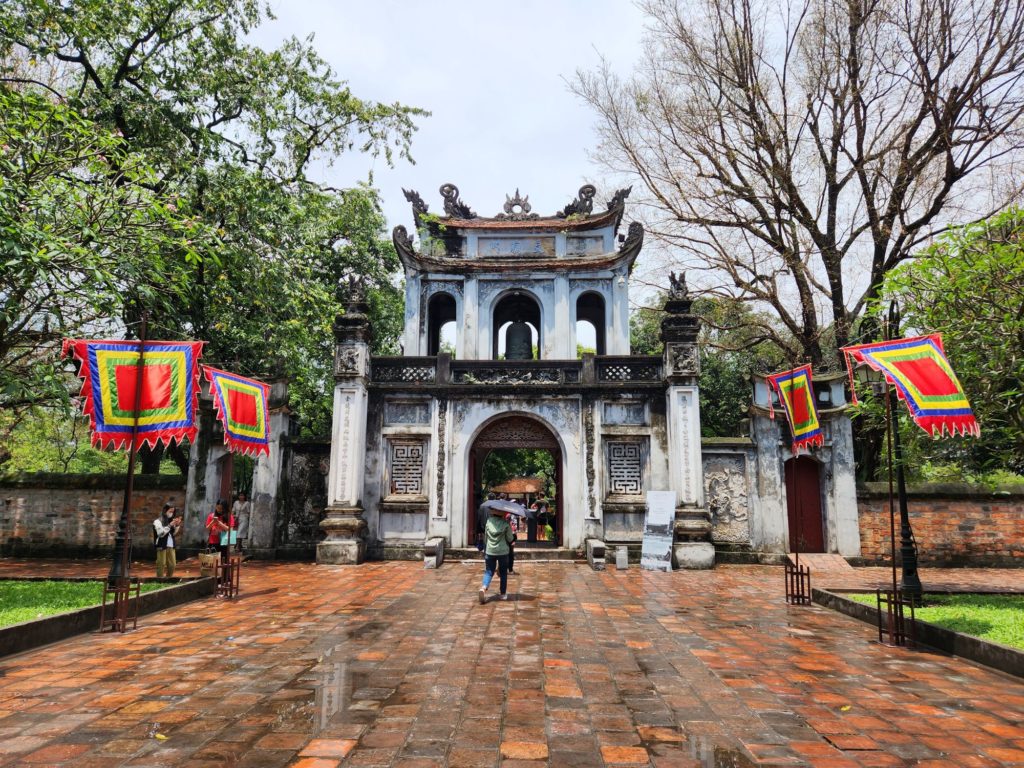
Five courtyards comprise the complex. These courtyards served different purposes when it was a university. The first two courtyards, graced by large banyan trees and other beautiful plants, were designed for relaxation. In the third courtyard, you can see the steles, large stone tablets with the scholars’ names carved into them, sitting atop stone turtles. The writing is faded by now, but it is such a cool piece of history to see in real life.
The altar to Confucius sits in the fourth courtyard. Here, you can find people praying and leaving offerings to Confucius. It is very much a religious site, so make sure to be respectful when entering. Of course have your shoulders and knees covered, and respect the people praying and leaving offerings.
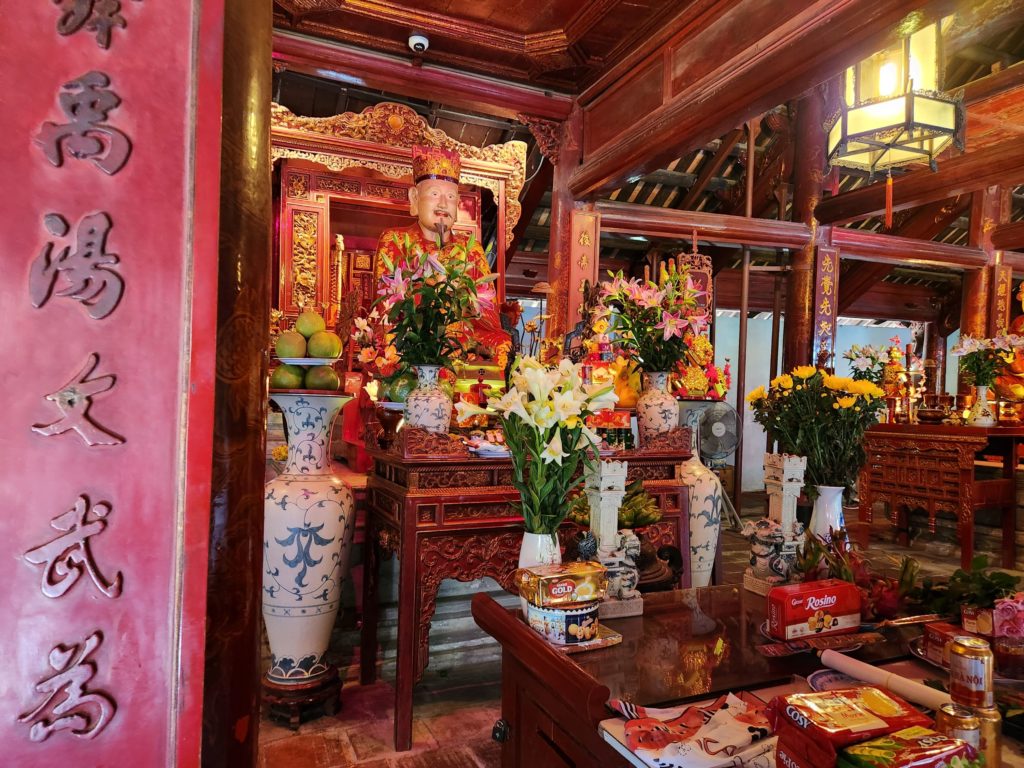
After getting a good fill of history, we were hungry for food. We hadn’t eaten all day up until this point and wanted to find some banh mi. So we headed for what I think is Hanoi’s most popular banh mi stall.
It’s recommended all over the internet – it’s on every travel blog about Hanoi and clearly very popular with tourists. When you approach it, you’ll see a long queue of tourists. The line does move pretty quickly, but it still takes awhile to actually get your food. We got there around 2 p.m., and it was at least 20 minutes before we got our food. That was our longest wait for food in our entire time in Vietnam.
I was excited to try Hanoi’s most famous banh mi and very hungry.
After a banh mi, we decided to find a bia hoi, a corner restaurant where they served cheap and refreshing draft beer. We ordered two Bia Ha Nois and just sat and observed the city.
That evening, following a jet lag-induced afternoon nap, we decided to go out again to try to find a pair of sunglasses at the Old Quarter night market. When we got to the market around 9 p.m., it was in full swing and much more crowded than the night before. We walked through part of the market in shoulder-to-shoulder traffic and decided to get out of the crowds.
Resolving to come back earlier the next day, we left the market and found a place serving pho ga. I’d read pho ga (chicken pho) was more common in the north, so it had been on my list to eat in Hanoi. We ended the night with another item on my list: sugarcane juice. It was good, but also very sweet, and I couldn’t drink more than a few sips. Luckily, it was only 10K VND, so I didn’t feel too bad about being unable to finish.
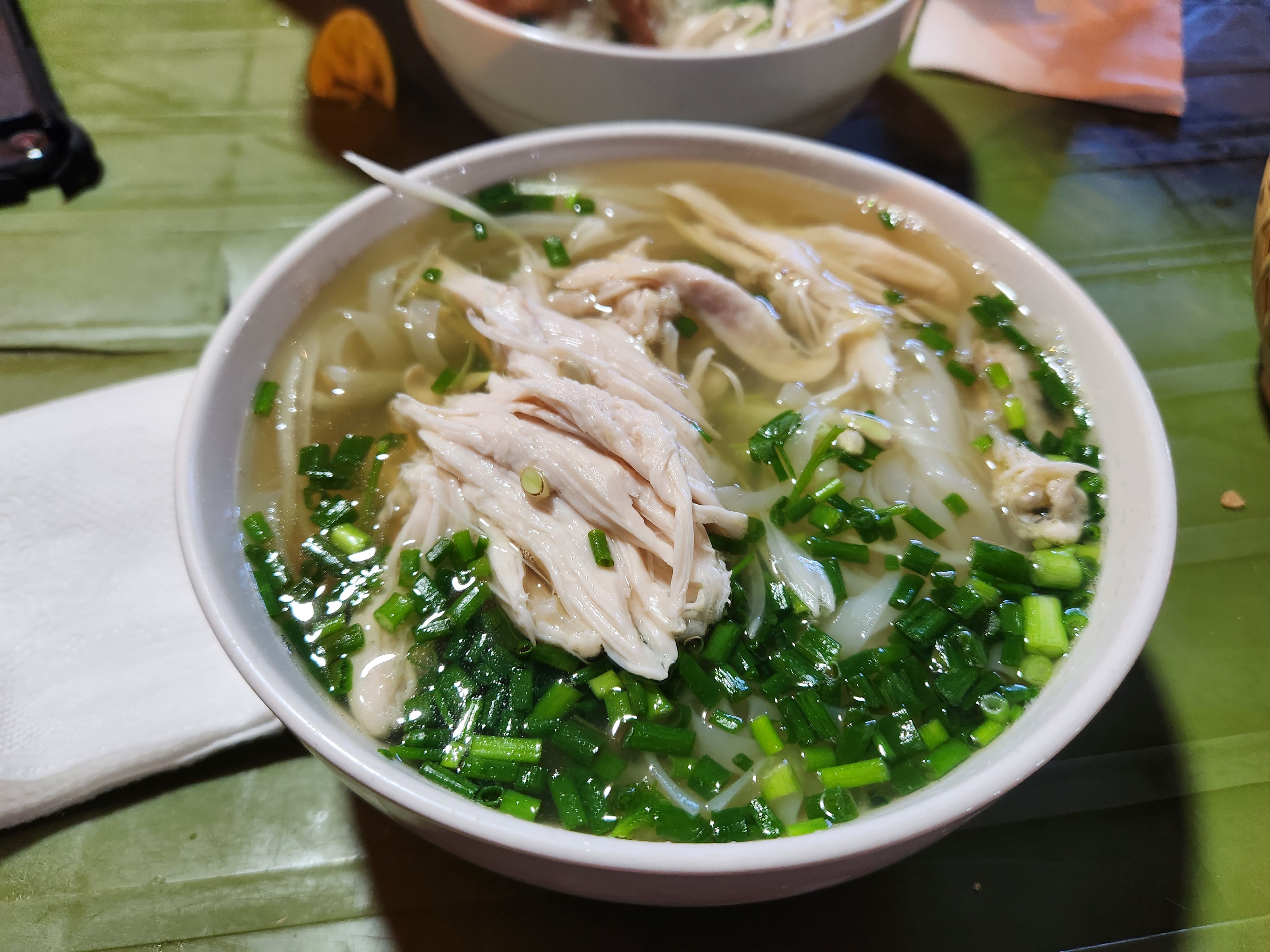
Day 3: Train Street, Bún chả & Hoàn Kiếm Lake (during the day)
Having accomplished two of the big things we wanted to do in Hanoi the day before (plus a lot of walking), we were ready for a more chill day. The first two things on our list were to see Train Street and get some egg coffee, possibly at the same time.
Hanoi’s Train Street is famous for being a narrow residential/business street where a train passes closely by the buildings. Maybe you have to be there to understand the excitement, but it’s interesting to see how residents can just go about their everyday lives while living and working practically on top of the train tracks.
Due to safety concerns, tourists are officially not allowed to visit Train Street. However, plenty of tourists still find their way onto the tracks. I wrote more about my Train Street experience in another post, but we did make it onto the tracks via a business owner who helped us cross in exchange for patronizing her cafe.
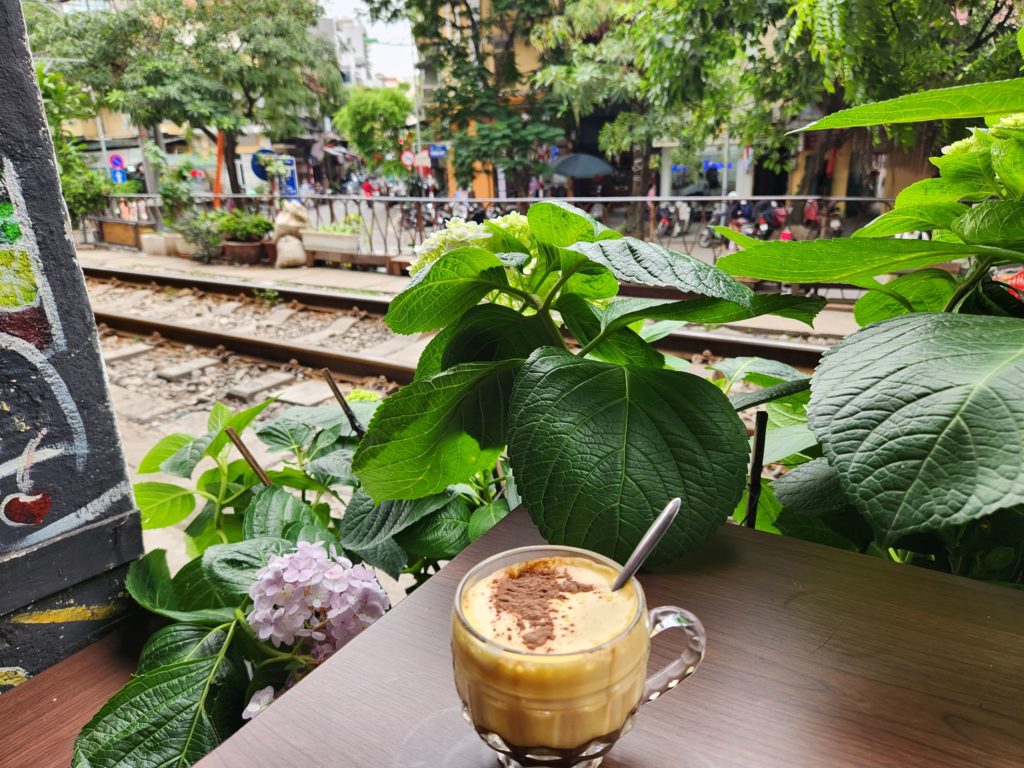
The gist of the story is, we drank some egg coffees, then got impatient waiting for the train. We left at exactly the wrong time but ultimately did get to see the train pass by – from the opposite side of the tracks. My greatest piece of advice is to try to be patient waiting for the train, even if it’s 40 minutes later than what you thought the schedule said.
After all the excitement of Train Street, we decided it was time to get Hanoi’s most famous dish: bún chả.
We actually originally planned to get it for dinner the day before, but then learned it was more of brunch/lunch dish.
Anthony Bourdain helped bring international attention to it by dining in a bún chả restaurant with Barack Obama in 2016. It is a dish of pork in a flavorful broth with onions and chilis, and vermicelli noodles served with a side of herbs. You eat it by flavoring the broth with the fresh herbs, then dipping the noodles in the broth and eating them with the grilled pork pieces. Most bún chả we saw also came with a side of crab spring rolls.
You can eat at the exact location in Hanoi where Obama and Bourdain got bún chả and order the “Obama Special” – bún chả, nem cua bể (crab spring rolls) and a bottle of Bia Hanoi. However, I decided I wanted to find a less well-known restaurant.
We ended up at a small bún chả place in the Old Quarter that was absolutely delicious. The pork pieces were juicy and perfectly charred, and the broth was flavorful. The place was pretty full when we got there, but we sat in a back corner and ordered two bun cha and one plate of spring rolls. Honestly, it was a lot of food. If you don’t have a big appetite, I might recommend just ordering one bún chả to split between two people.
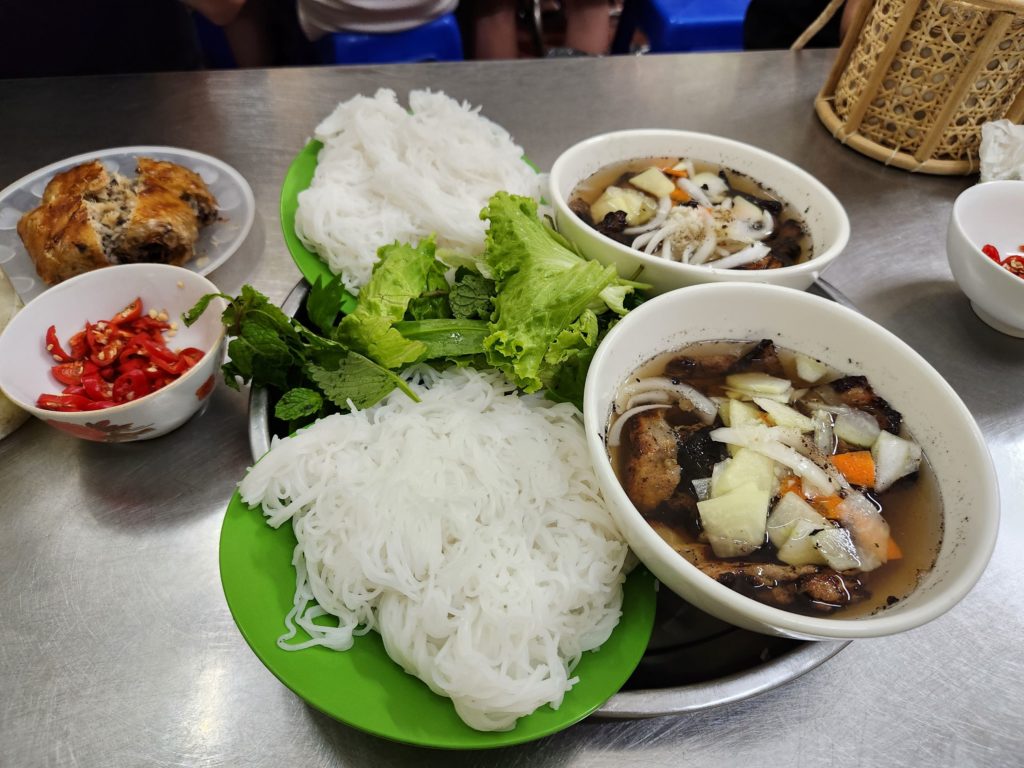
After a delicious meal, we understood why bun cha is a popular dish to eat before an afternoon nap.
However, we wanted to observe what Hoàn Kiếm Lake was like on a Sunday afternoon compared to a Friday night.
We really enjoyed taking in the vibe around the lake during the day. The area was still mostly inaccessible to motor vehicles. One of the most interesting parts was how multiple streets were blocked off for kids to ride on scooters and toy cars, paint pottery and basically just enjoy being kids.
Our legs were tired after two laps around the lake. We stopped at another bia hoi then decided to call it a night. We had to wake up early the next day for our trip to Ha Long Bay.
Day 4: Hỏa Lò Prison, Phung Hung Mural Street & Final Night Market Attempt
After three days cruising Ha Long Bay and two days trekking in Sa Pa, we were in Hanoi for our final full day in Vietnam’s capital. The overnight train from Sa Pa arrived in the Hanoi Old Quarter at 5:30 a.m. Our Airbnb was only a six-minute walk from the train station, but check-in was not until 2 p.m. Luckily, we were able to drop our bags at the reception area and hang out on the shared terrace until Hanoi started coming to life.
(Note: If you need to store your bags before or after catching a train from the Hanoi station and don’t have an Airbnb or hotel with a reception that will do it for free, you can pay to store them at the station. There are self-serve luggage lockers, and the cost is based on the amount of time needed. When we were there, the luggage lockers were out of service, but you could still store your bag at the ticket counter.)
Around 8:30 a.m., we decided it was time to venture out. We grabbed a coffee then headed to Hỏa Lò Prison Relic, a preserved piece of dark history. What was initially a village where pre-colonial Vietnamese made and sold stoves became transformed into a prison by the French during colonization.
The first part of the prison relic details how the French imprisoned and tortured Vietnamese revolutionaries during colonization. Exhibits include a guillotine and an array of torture weapons used on prisoners.
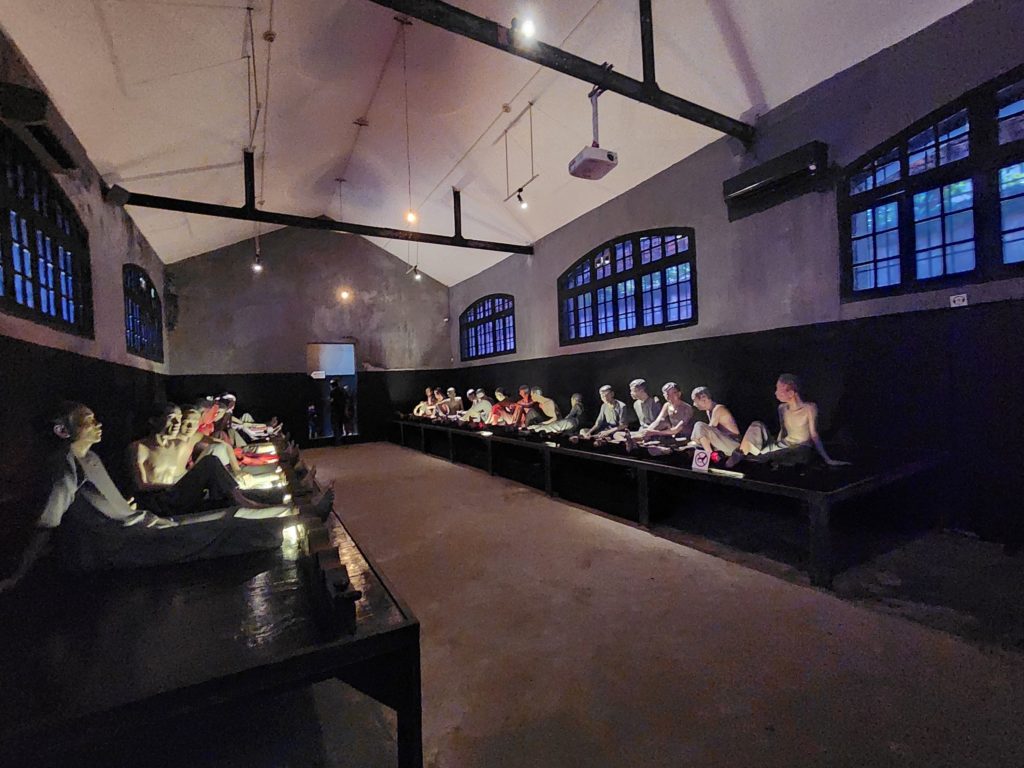
The next part of the relic is about the American/Vietnam War. If you’re American, it immediately confronts you with everything the US inflicted on Vietnam during this time period. The exhibit detailed some of the history behind the war, then discussed Hỏa Lò’s role.
In the context of this war, Hỏa Lò is also known as the “Hanoi Hilton.”
It housed American prisoners of war. This part of the exhibit focused on all the ways in which the American POWs were treated well during the war.
It was a big contrast from the final exhibit, which was about how Vietnamese prisoners were tortured in prisons during the same war. Suffice to say, Hỏa Lò Prison Relic is a very somber but important site to visit in Hanoi.
Overall, we spent about 90 minutes at the Hoa Lo Prison taking our time going through the exhibits and reading nearly all the signs. It’s one of the smaller museums we visited in Vietnam.
We finished our tour of Hỏa Lò Prison around 10:30 a.m. However, we’d been awake since our overnight train arrived at 5:30 a.m. and needed another coffee. On our Ha Long Bay cruise, we learned about a coffee shop that claimed to have the best egg coffee in Vietnam.
We walked back towards Hoàn Kiếm Lake to find this coffee shop, then down a small alley to find the entrance. The first floor of the cafe had almost no one in it, and the employees instructed us to go upstairs. Upstairs was bustling, there were multiple seating areas with people enjoying egg coffees. We found a spot with two seats and picked up a menu that had every permutation of egg coffee, cream or cocoa you can imagine.
This cafe also offered an iced egg coffee. Everywhere else only offered hot egg coffee. It tasted like a milkshake.
Next, I wanted to go to Bach Ta Temple.
Bach Ta Temple is one of the temples that made up the Thong La Citadel around the city. I realized I wasn’t dressed appropriately to enter as we approached the temple. See, it was one of the hottest days of the year so with a “real feel” of 115 fahrenheit, so I dressed in a small romper with spaghetti straps. It was the hottest day we’d experienced all year. Although we didn’t plan well enough to see the temple, it was luckily on the way to the next stop we wanted to see: Phung Hong Mural Street.
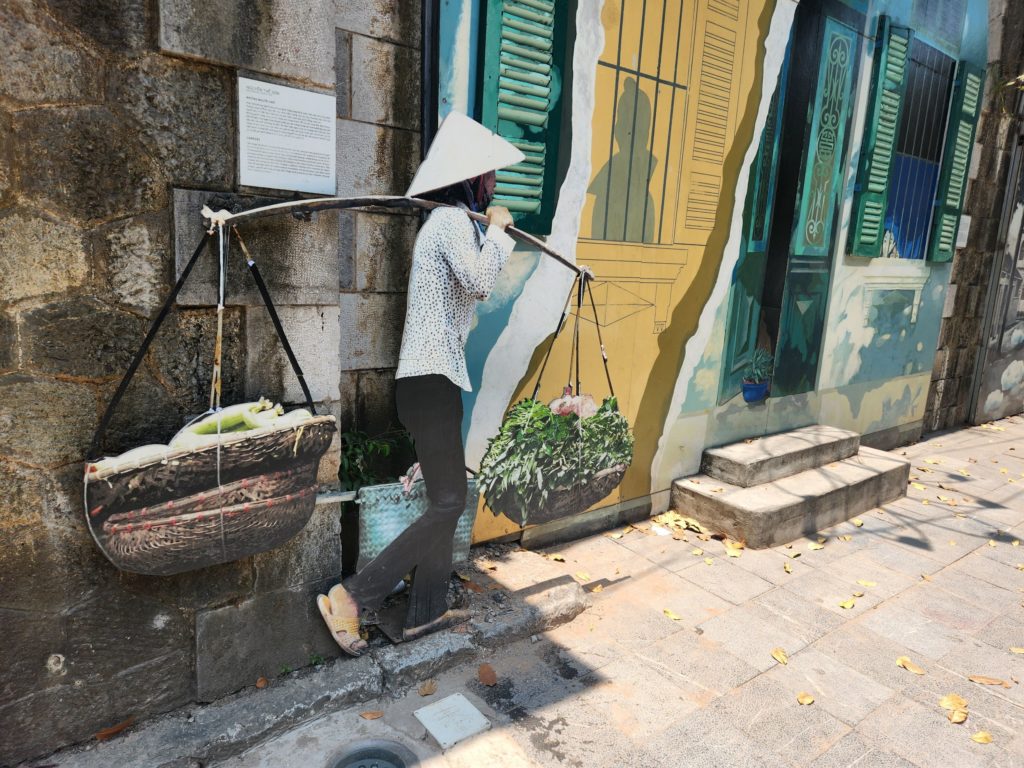
Phung Hong Mural Street is a stretch of the street not far from Train Street where people have painted life-sized murals. The murals were done in partnership with South Korea to celebrate 25 years of political harmony. From my understanding, young adults created the murals, interpreting Vietnam’s recent and distant history. The murals most often depicted a young adult looking back on a traditional city or market. My favorite was a look into the Long Bien train station. It was mesmerizing, and the medium used to depict it stood out so much from the other murals.
By this point, I’d gotten a message from our Airbnb host that we could check in earlier than expected. It was the hottest part of the day on the hottest day we’d experienced so far, so we decided to grab some food and make our way back to our Airbnb.
After waiting out the hottest part of the day (and maybe napping a little), we ventured out to the night market one more time.
We were determined to find two pairs of sunglasses but only had 170K VND.
I’d learned in Sa Pa that haggling was not only expected but required and encouraged in Vietnam. So I felt confident I’d be able to get us sunglasses at our price. And I did!
Happy with our purchases, we headed to get my new favorite Vietnamese dish of Bun Bo Nam Bo (beef noodle salad). Then, it was time to head back and get ready to leave Hanoi the next day.
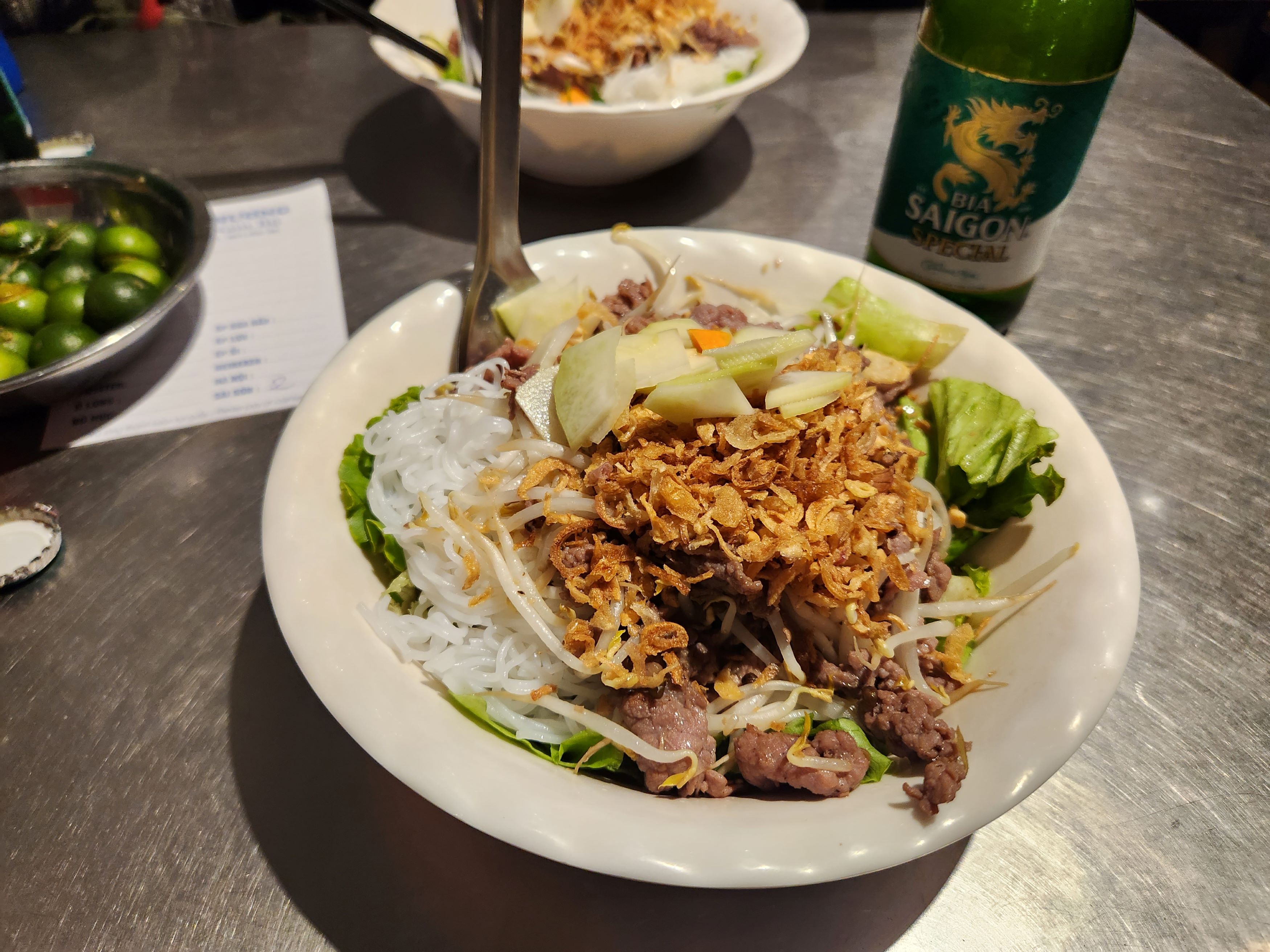
What we didn’t get to see:
There were three big things we didn’t get to see when we stayed in Hanoi:
- Museum of Ethnology: A museum about Vietnam’s officially recognized ethnic groups
- Women’s Museum: A museum about women’s contributions to Vietnamese history and culture
- Perfume Pagoda: Buddhist complex made of temples and shrines carved into limestone mountains, a popular day trip from Hanoi
I’m sure there’s much more.
Tips for Hanoi:
Where to stay:
The best place to stay in Hanoi is the Old Quarter, especially if you only have a few days in the city. The biggest tourist sites are in this neighborhood, so staying here guarantees you’ll be walking distance (or cheap Grab distance) to many of the city’s highlights.
Safety:
Hanoi and Vietnam in general are safe. We felt completely safe the entire time in Vietnam. We heard you have to be careful about opportunists trying to snatch your phone on motorbikes near the train station in Old Quarter, so we were a bit more careful while walking around that area.
One thing to note is that people will try to scam you by overcharging. Do your research to know what you’re expected to pay and try to haggle when needed. If you’re from a place like the US/Canada/Europe/Australia, the scam likely won’t cost you more than a couple dollars if you get caught in it.
Food:
There’s so much good food in Vietnam. People are often concerned about food safety, but a good rule of thumb is to stick to places that are somewhat busy. Also, make sure the broth is still hot/boiling so you know it’s fresh.
You can also look up reviews on Google, but a lot of restaurants are not on Google in Hanoi. You’ll miss out on a lot of great street food if you try to stick only to what’s on Google Maps. I never had any issues with the food in Vietnam.
Getting Around:
There are a few ways to get around in Hanoi.
- Walking: Once you get used to the chaos of the traffic, Hanoi is pretty walkable, especially in Hoàn Kiếm District.
- Bus: The bus can be a good way to get between different districts and costs between 7K – 15K VND.
- Grab: Grab is Vietnam’s ride share service similar to Uber or Lyft. You can download an app on your phone to call rides and pay in cash or card. You can order a Grab car or Motorbike!
- Taxi: You can also take an official taxi, but make sure to agree on a price up front to try to avoid scams.
- Motorbike: Plenty of tourists rent or buy motorbikes to get around Vietnam. Note that international drivers licenses are not legally recognized in Vietnam.


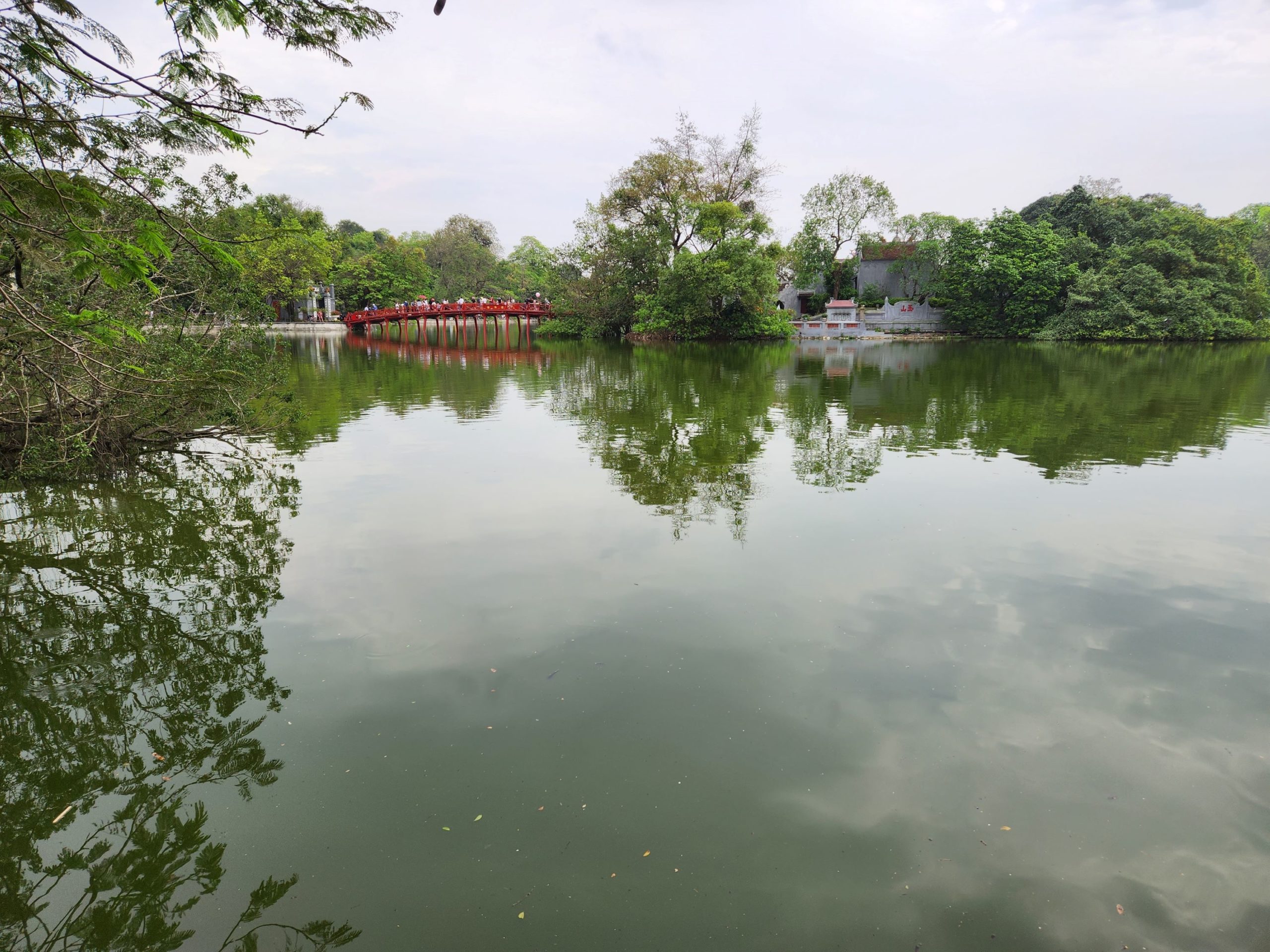
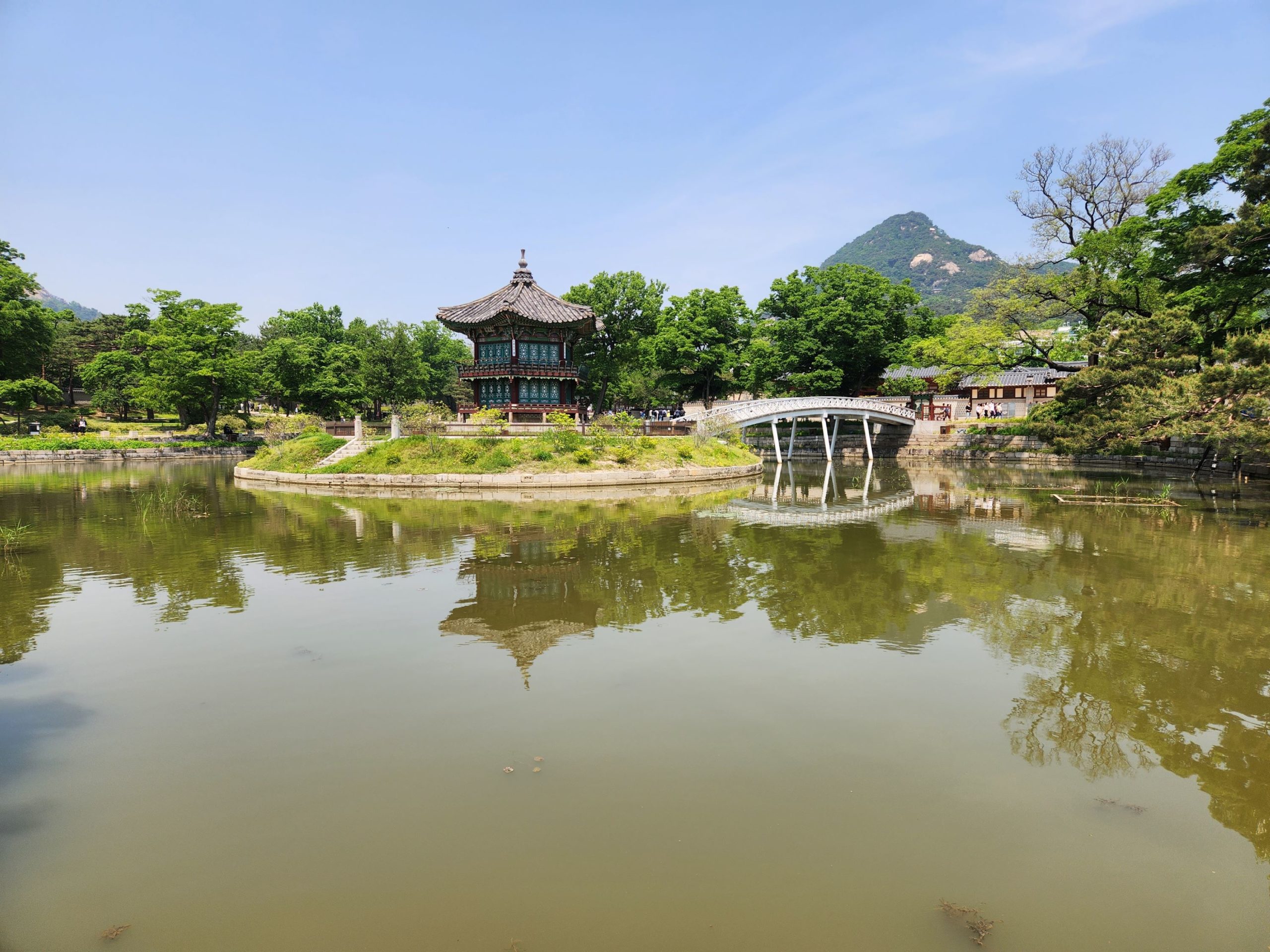
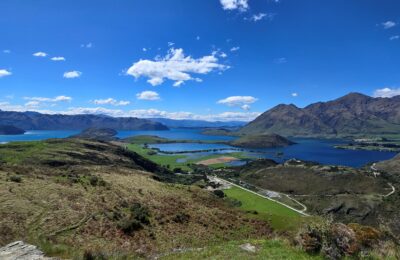
7 thoughts on “Hanoi: How to Spend Half a Week in Vietnam’s Capital”